
Six Ways to Think out of the Box
June / May, 2012 Co-Author: Vikram Chauhan, CUA
Six Ways to Think out of the Box: A guide to engineering award-winning ideas (that are persuasive too!)
Goldenberg, J., Mazursky, D., Solomon, S., The Fundamental Templates of Quality Ads, Marketing Science, Vol. 18, No. 3, March 1999, pp. 333–351
Ask any creative director of any advertising agency and he will tell you that creative ideation is a highly complex thinking process — difficult to institutionalize and control.
Or…maybe not.
89% of award-winning ads could be classified by just six templates
An experiment conducted by an Israeli research team in 1999 shows that even in a complex thinking process certain patterns of creativity emerge. The team assembled a group of 200 award-winning, highly regarded ads, and after studying them, decided that 89% could be classified by just six templates. (Just like the “seven basic plots” that all stories follow.)
The research team also tried to use their six templates to classify 200 other ads that had not received awards. When the researchers tried to classify these less successful ads, they could classify only two percent of them.
The researchers didn’t stop there. They asked three test groups of ordinary people to create ads and then tested them with consumers. The ads created by the test group, trained for just two hours to use these six templates, were rated 50% more creative than ads created by other test groups. Also, the consumers in the experiment were 55% more positive about the products and services featured in the template-driven ads than the products and services featured in the non-template-driven ads.
The Bottom Line: Highly creative ads are more predictable than uncreative ones. If you want to spread your ideas to other people, you should work within the confines of the rules that have allowed other ideas to succeed over time. You may want to invent new ideas, not new rules.
The REAL Bottom Line: This research is based on award-winning ads. And the award-winning ads may not necessarily be the most persuasive. (Ergo, it’s not surprising that every advertising award ceremony sees a number of “not so genuine ads” submitted each year only to win awards.)
To achieve REAL results, you need to understand the deep intellectual and emotional drives and blocks of your customers. You need to engineer a solid theme, frame and meme based on these insights and use scientific persuasion tools to support them. Then, you may use any of these six templates to create ads that not only are award-winning, but get the desired results.
Or maybe, as T.S. Elliot put it: “I always feel it’s not wise to violate rules until you know how to observe them.”
The Six Creative Templates are…
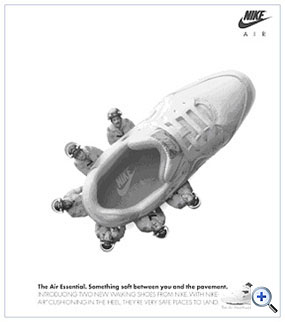
Nike ad shot from the perspective of someone jumping from a tall building. A group of firemen is on the street below, preparing to cushion the jumper’s fall with an oversized Nike sneaker. The tagline reads: “Something soft between you and the pavement.”
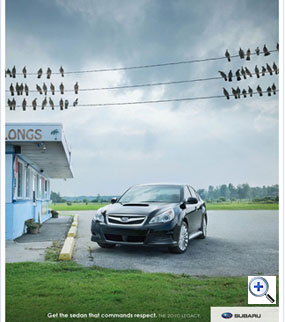
Subaru commands so much respect (the key message) that even a pigeon can’t taint it.
Template #1:Pictorial Analogy
1) Pictorial Analogy Template: The pictorial analogy template is obtained when a product (e.g., sneaker) or one of its attribute/key messages (e.g., safety of the sneaker) is shown as a symbol (e.g., safety net). This template has two versions:
The Replacement Version: The symbol is transplanted.
The Extreme Analogy Version: The symbol is taken to the extreme.
Template #2: Extreme Situation
2) The Extreme Situation Template: Product is shown performing under unusual, exaggerated circumstances.
The extreme situation template depicts situations that are unrealistic in order to emphasize the prominence of key attributes of a product or service (e.g., safety). This template has three versions:
The Absurd Alternative Version: The idea of this version is to present a tongue-in-cheek suggestion to the viewer: “You don’t have to buy our product. There are alternative options for achieving the same results, such as . . .”The alternative option is presented in a seemingly serious manner, but contrary to the declared position of the advertiser, the viewer will draw the conclusion that such an alternative is absurd and ridiculous.
The Extreme Attribute Version: Situation in which either the attribute of a product (or service) is exaggerated to unrealistic proportions.
The Extreme Worth Version: Situation in which the worth of either a product or service is exaggerated to unrealistic proportions.
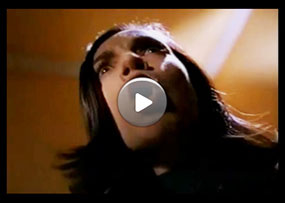
This TV commercial for Schlage locks shows a woman barking to scare away a burglar. It conveys the message that a safe and peaceful evening can be achieved either by buying a certain lock or by barking.

This TV commercial for Jeep shows the car being driven underneath snow to demonstrate its all-weather driving capacity.
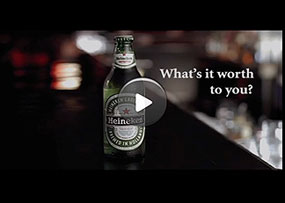
This TV commercial for Heineken shows how people in a bar go to unrealistic extremes to win a bid for the last bottle of Heineken.
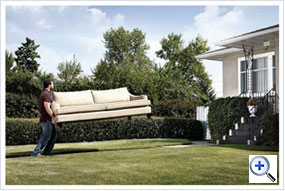
The extreme consequence of using Gold’s Gym - You don’t need anybody to help you move in.
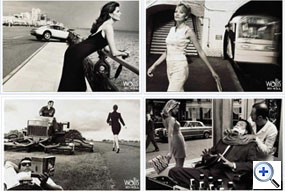
The extreme consequence of dressing well – The Wallis “Dressed to Kill” series.

This TV commercial for Pioneer loudspeakers shows a bridge on the verge of collapse when the loudspeakers of a car parked on it are turned on at high volume. The message is that the music can be played so loudly that even the sturdy foundations of the bridge are threatened by its impact.

This TV public service announcement on drugs warns that if you don’t stop taking drugs, your brain will end up like an egg on a hot frying pan.
Template #3: Consequences
3) The Consequences Template: Indicates the implications of either executing or failing to execute the recommendation advocated in the ad. This template has two versions:
The Extreme Consequences Version: Points out unexpected consequences of a product attribute
The Inverted Consequences Version: Warns against the implications of not executing the recommendation of the ad.
Template #4: Competition
4) The Competition Template: A product is shown winning in competition with another product or event. The selection of the other product or event is guided by its expected superiority over the advertised product, and hence the other product is from a different class/category.
One can also show competition with an event. For example, a person is shown contemplating whether to continue eating the (advertised) cereal or answer a ringing phone.
This template has three versions:
The attribute in competition version: This relates to whether the competition challenges an attribute of the product.
The worth in competition version: This relates to whether the competition challenges the worth of the product.
The uncommon use version: The idea is to emphasize a product attribute by applying it to solve a problem in a context totally different from its intended use. The typical elements that appear in this version are: a problematic scenario or issue, and ambiguity as to the product being the subject of the ad when the problem or dilemma is presented.
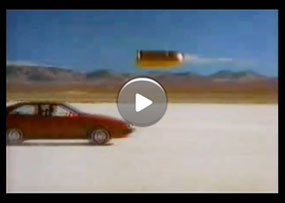
This tongue-in-cheek TV commercial shows a race between an Isuzu car and a bullet.
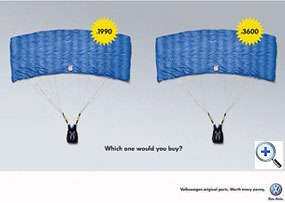
The competition here challenges the worth of the product by being cheaper than the original. But the agency manages to turn the weakness around by saying that even though original VW parts are more expensive than the competition, when safety is at stake, it’s “worth every penny.”
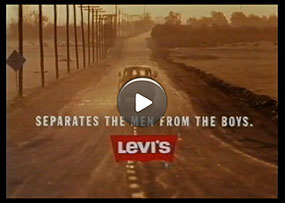
This TV commercial for Levi’s jeans shows a couple in a broken-down car being towed by a pair of jeans tied to the rescuing car.

Rub your scalp against the black strip of this print ad to check for dandruff and evaluate the need for the product.

ment. Rub your scalp against the black strip of this print ad to check for dandruff and evaluate the need for the product. Pull the orange tab as shown in the images above to remove the ink stain on the shirt.
Template #5: Interactive Experiment
5) The Interactive Experiment Template: Consumers can interact directly with the product. See for yourself! The interactive experiment template induces realization of the benefits of the product by requiring the viewer to engage in an interactive experience with the medium in which the ad appears. This template has two versions:
Activation version: By actually engaging in an experiment.
Imaginary version: By just imagining the performance of such an experiment.
Template #6: Dimensionality Alteration
6) The Dimensionality Alteration Template: The result of using or not using a product is dramatized by a leap in time that shows the long-term consequences.This template has four versions:
The New Parameter Connection Version: Unrelated parameters become dependent. Example: The speed of a new aircraft is demonstrated by reducing the size of the ocean.
The Multiplication Version: Multiply the product and compare the duplicates.
The Division Version: Divide the product into its components and create some form of relationship between them.
The Time Leap Version: A time leap that shows the long-run implications of a decision.
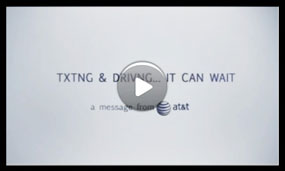
This TV commercial is a national effort to raise awareness about the risks of texting and driving, sponsored by AT&T. It shows the long run implication of the decision to text while driving.
References
Goldenberg, J., Mazursky, D., Solomon, S., The Fundamental Templates of Quality Ads, Marketing Science, Vol. 18, No. 3, March 1999, pp. 333–351
















